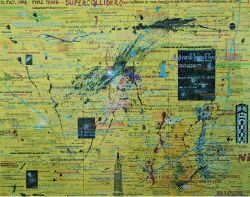Keith Tyson
South London Gallery, London, UK
South London Gallery, London, UK

For an artist best known for slavishly making whatever his 'Art Machine' asked of him, Keith Tyson's most recent exhibition at the South London Gallery was really quite epic. The size of the paintings alone matched those recently shown in the same space by Julian Schnabel and Anselm Kiefer, but in a way that's hardly the issue: the physical dimensions of the work pales into insignificance beside the scope of their contents, which in several instances is nothing short of the entire universe.
The back half of the gallery was occupied by Field of Heaven (all works 2001), an awkward-looking armature that rotates at several points, like a fairground ride. It sits on an enormous cylindrical plinth that lends it the appearance of an ill-conceived public sculpture with a rather perplexingly inflated sense of self-worth. Sooner or later you direct your attention to the 12 small chunks of rock impaled like marshmallows on the tip of each rotating prong. These include various exotic minerals, such as gold and pyrites, and fragments of celestial bodies belonging to our solar system: a shard of meteorite, a bit of the moon and a similar-size chunk of Mars. (Since when could you get hold of some of that?) All this is set in an eccentric sequence of orbits of Tyson's own devising that's rather less elegant than the concentric model we learned at school. Tyson may be playing God with this sculpture, but its tiny bits of our planet and neighbouring orbs rotate as forlornly as goldfish circling in their bowls.
To the right of Field of Heaven was a huge 12-part painting, A Night in a Billion. Each framed panel is a realistically rendered fragment of a night sky bejewelled with twinkling stars. The overall image makes sense whichever order or way up the panels are arranged, but the chances that you'll see it again in exactly the same configuration are an inconceivable 11,771,943,000,000 to 1 (as inconceivable as the fact that there are that many stars in the universe, of which the sun is just one).
The rear wall of the gallery was covered by another enormous painting, Nature - A Window on an Infinite Cellular Blanket, a vast field of polygons in various shades of grey. Generally, the shapes are individually discernible, but in a few areas they appear to shrink in size and increase in density, as if they're being sucked into black holes.
Blanket and Field, along with A Tiny Bubble of Complexity - a giant translucent orb that changes colour with the heating and cooling of a tiny element inside - are three works from a recent series called 'The Seven Wonders' (2001). Its seven works, in ascending order of geometric complexity, attempt to give form to scale, from the infinite to the infinitesimal. A sense of numbness pervades this futile endeavour, and becomes more noticeable the larger the painting or sculpture. Tyson's 'outsider' science also suggests that astronomy, though dealing with unparalleled scales of space and time, seems curiously void compared with the heterogeneous plenitude of our own minuscule lives.
This theme is taken up by Supercollider, a massive work on paper, again concerned with scale, and mainly comprising a list of hundreds of radically unrelated observations: 'a password memorized by members of an underground fetish club', 'the heat fluctuations inside a frying sausage', 'a 200cm long bar of 10cm diameter polished steel', 'the view from Cologne Cathedral'. Tyson painted these fragments in a variety of sizes and typefaces that have no relation to their relative importance; the overall effect evokes the layered continuum of consciousness. Since these wildly disparate scraps of meaning aren't reducible to a specific area of knowledge, it's impossible to find a meaningful route through them all, a realization that left me anxiously pondering whether this flat-line of disconnected stuff really is the sum total of it all.
The third sculpture, Random Tangler (A Recursive Transition Knot), recalls an absurdly complicated board game, unpacked from its equally complex wood and green felt box, the mind-boggling 'rules' of which are outlined on the underside of the box's lid. Four round islands protrude from each side of a central square covered in a grid of around 100 movable, cryptically marked white tiles. Various trashy but esoteric elements surround the piece: a Gothic-looking mast of a tall ship covered in black gaffer tape; silver-sprayed plastic alligators circling a wheel hub; a black trainer metamorphosing into a black swan. The rules and the elements are as arbitrary as the utterances in Supercollider or the ideas for art works churned out by Tyson's currently decommissioned 'Art Machine'. Together they present the tragi-comedy of trying to make sense of life, whatever interpretative system is used, including the fluid and pluralistic medium of contemporary art.























